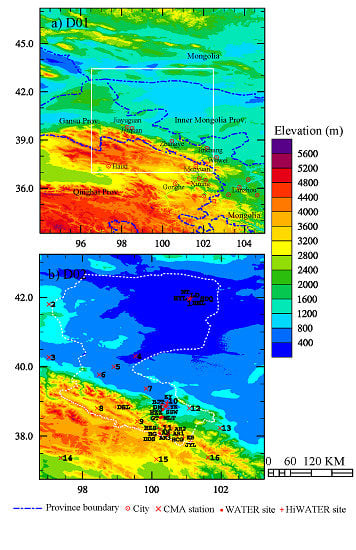Development and Evaluation of a River-Basin-Scale High Spatio-Temporal Precipitation Data Set Using the WRF Model: A Case Study of the Heihe River Basin
Abstract
:1. Introduction
2. Research Region and Validation Data
2.1. Research Region and Validation Data
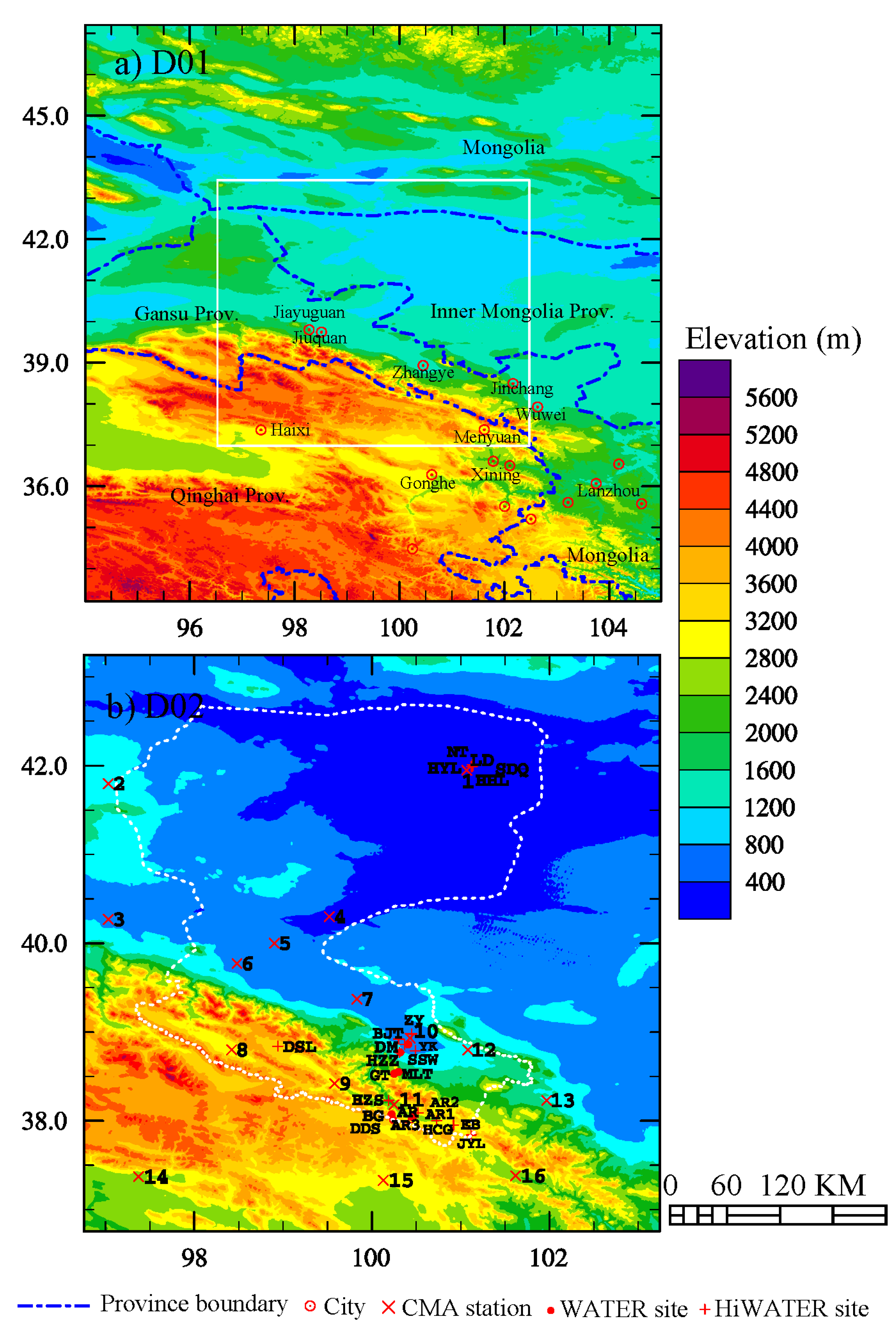
| Sub-Stream | Station Name | Station ID | Altitude (m) | Latitude (°N) | Longitude (°E) | Land Use |
|---|---|---|---|---|---|---|
| Upstream | Arou1 super station * | AR1 | 3033 | 100.46 | 38.05 | Alpine grassland |
| Arou2 | AR2 | 3529 | 100.52 | 38.09 | Same as Arou1 Sunny slope | |
| Arou3 | AR3 | 3536 | 100.41 | 37.98 | Same as Arou1 Shady slope | |
| Dashalong | DSL | 3739 | 98.94 | 38.84 | Swamp meadow | |
| Ebao | EB | 3294 | 100.92 | 37.95 | Alpine grassland | |
| Huangzangsi | HZS | 3529 | 100.19 | 38.23 | Farmland | |
| Huangcaogou | HCG | 3137 | 100.73 | 38.00 | Alpine grassland | |
| Jingyangling | JYL | 3750 | 101.12 | 37.84 | Alpine meadow | |
| Midstream | Bajitan | BJT | 1562 | 100.30 | 38.92 | Gobi |
| Daman super station * | DM | 1556 | 100.37 | 38.86 | Farmland | |
| Huaizhaizi | HZZ | 1731 | 100.32 | 38.77 | Desert | |
| Shenshawo | SSW | 1594 | 100.49 | 38.79 | Desert | |
| Zhangye | ZY | 1460 | 100.45 | 38.98 | Wetland | |
| Downstream | Sidaoqiao super station * | SDQ | 873 | 101.14 | 42.00 | Sparsely vegetated |
| Hunhelin | HHL | 876 | 101.12 | 41.99 | Mixture forest | |
| Huyanglin | HYL | 876 | 101.12 | 41.99 | Open Shrubland | |
| Luodi | LD | 878 | 101.13 | 41.99 | Barren land | |
| Nongtian | NT | 875 | 101.13 | 42.01 | Farmland |
2.2. Evaluation Methods
3. High Spatial-Temporal Precipitation Simulated by the WRF Model
| Items | First Domain (0.25°) | Second Domain (0.05°) |
|---|---|---|
| Horizontal | 44 × 56 | 120 × 130 |
| Time interval | 150 s | 30 s |
| Microphysics | Kessler | Kessler |
| Cumulus Parameterization | Kain-Fritsch | Kain-Fritsch |
| Planetary Boundary Layer | MYJ | MYJ |
| Longwave Radiation | RRTM | RRTM |
| Shortwave Radiation | Dudhia | Dudhia |
| Land surface model | Noah LSM | Noah LSM |
| Projection | Lat-lon | Lat-lon |
| Boundary | NCEP/FNL analysis | Domain 1 |
4. Results and Discussion
4.1. Error Analysis
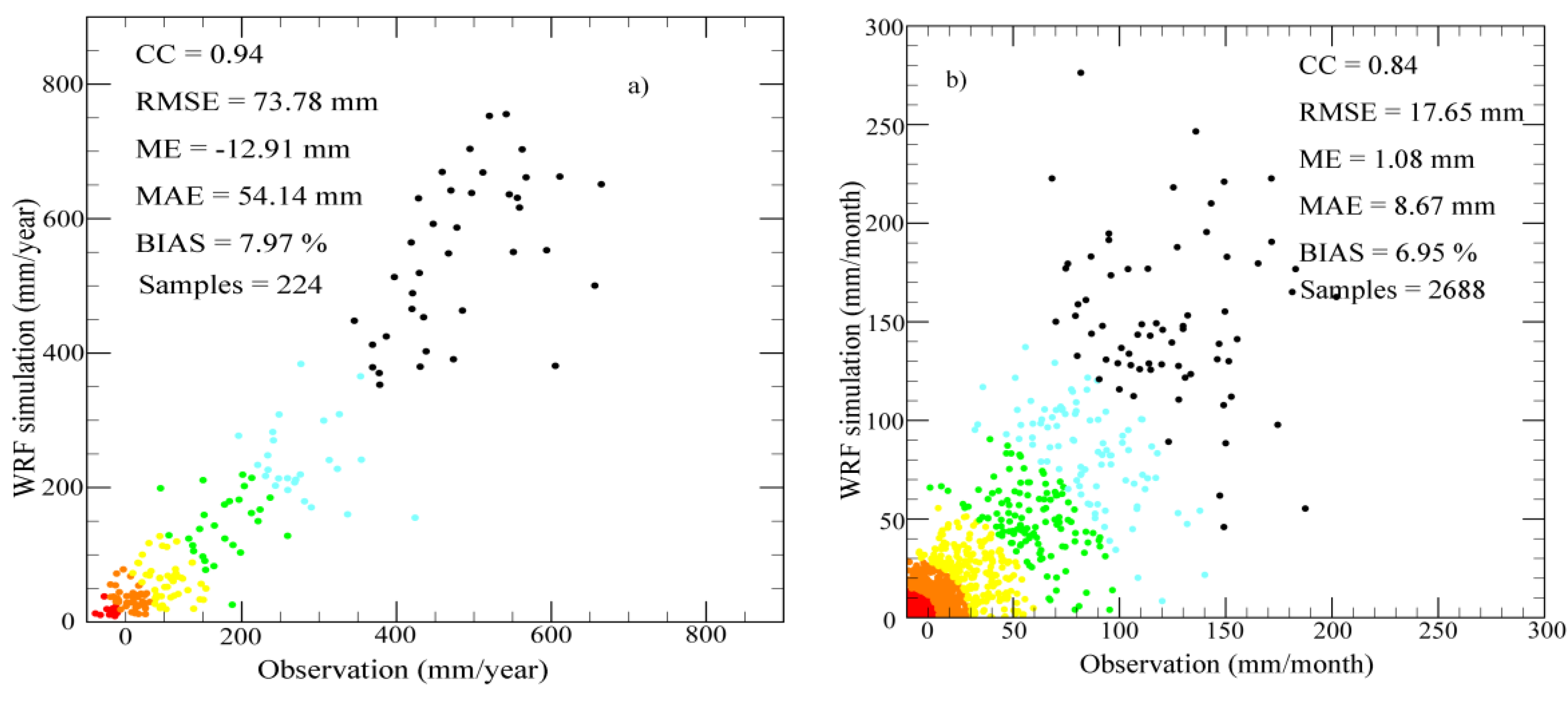
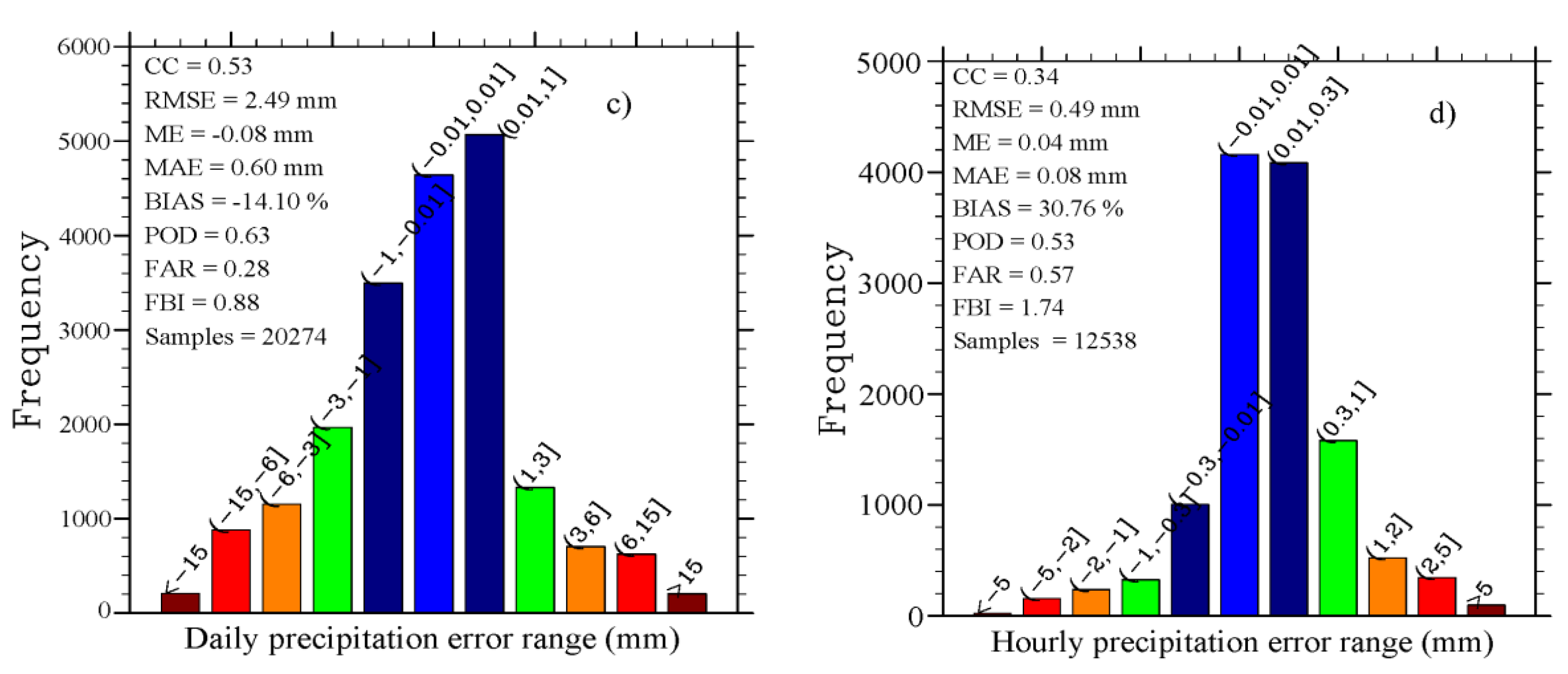
| Station | Precipitation flux (mm) | Error (mm) | ||||
|---|---|---|---|---|---|---|
| Observation * | WRF-P1 * | WRF-P2 * | WRF-P1 | WRF-P2 | ||
| Upper | Tuole | 373.27 | 311.50 | 395.80 | −61.77 | 22.53 |
| Yeniugou | 615.09 | 356.50 | 631.83 | −258.59 | 16.74 | |
| Qilian | 575.69 | 192.60 | 535.84 | −383.09 | −39.85 | |
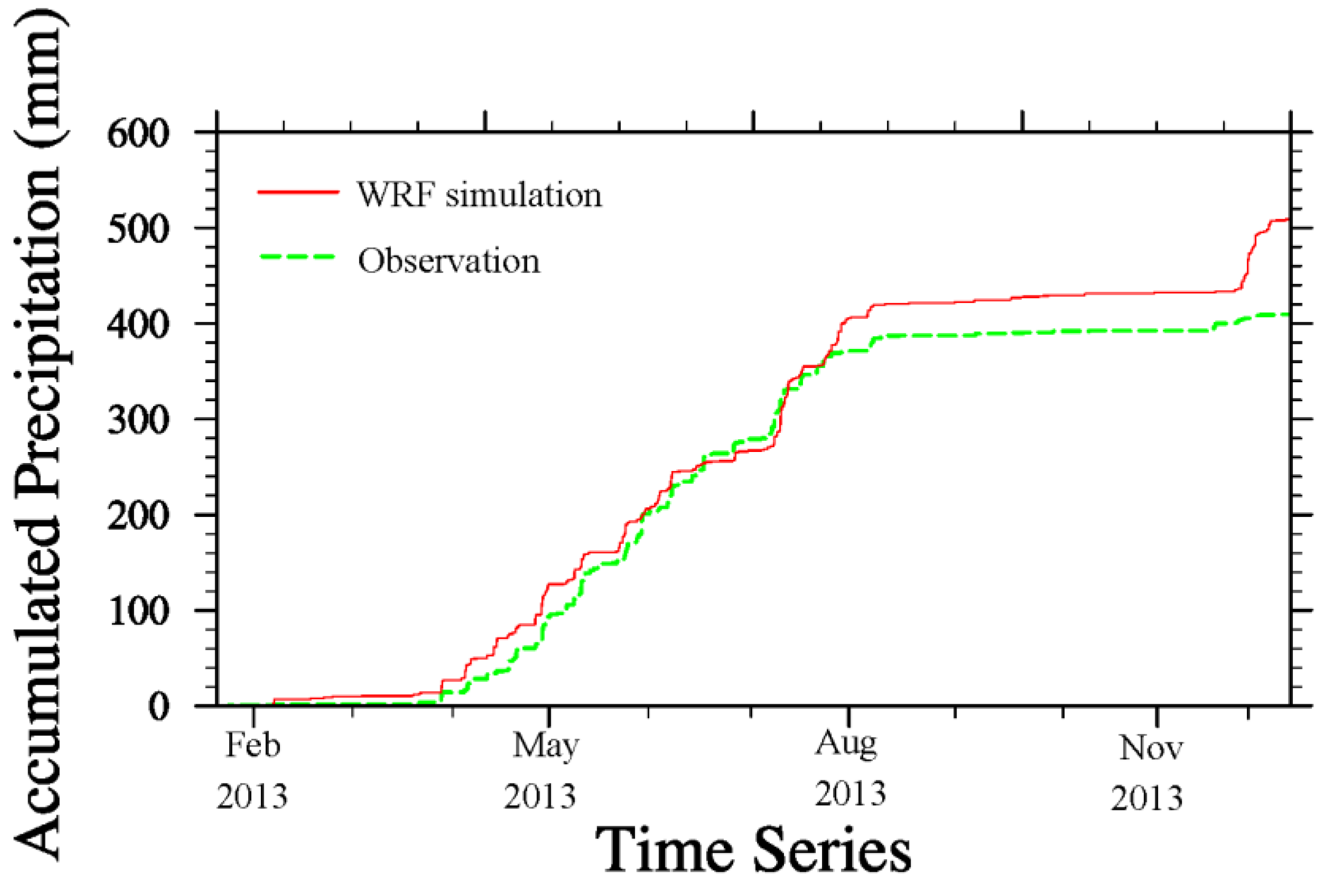
4.2. Spatial Precipitation Pattern

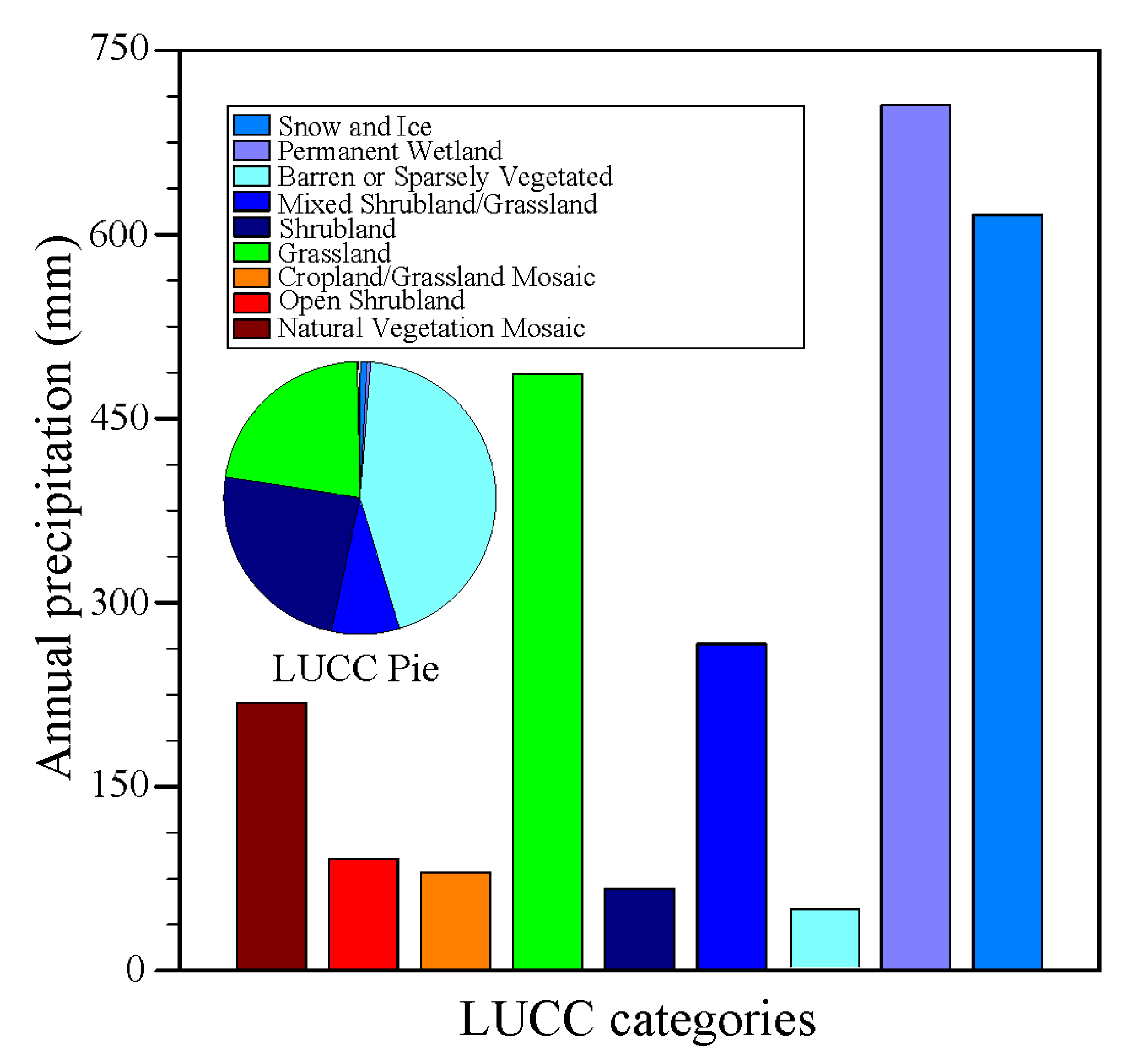
4.3. Temporal Precipitation Pattern
4.3.1. Annual Precipitation
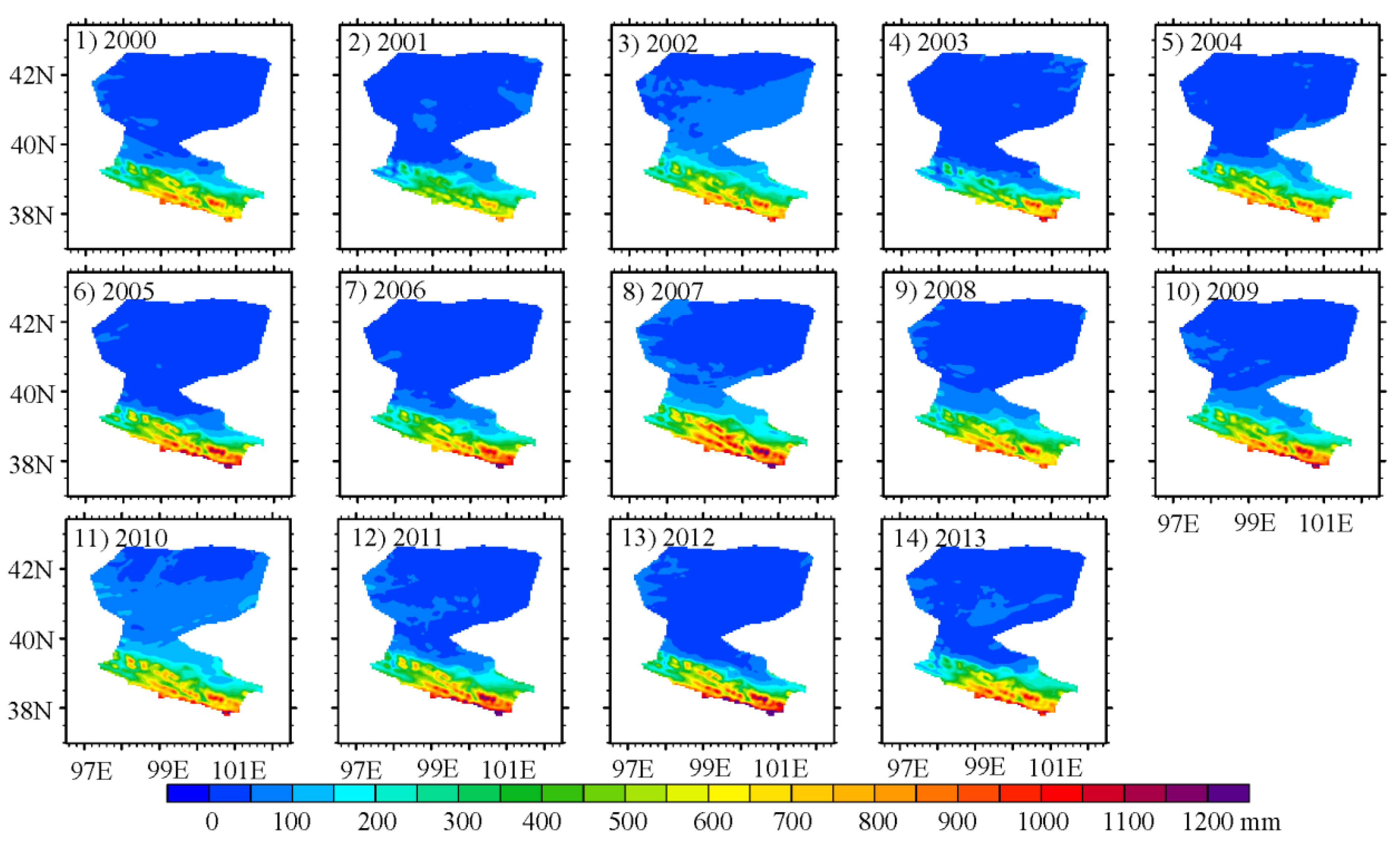
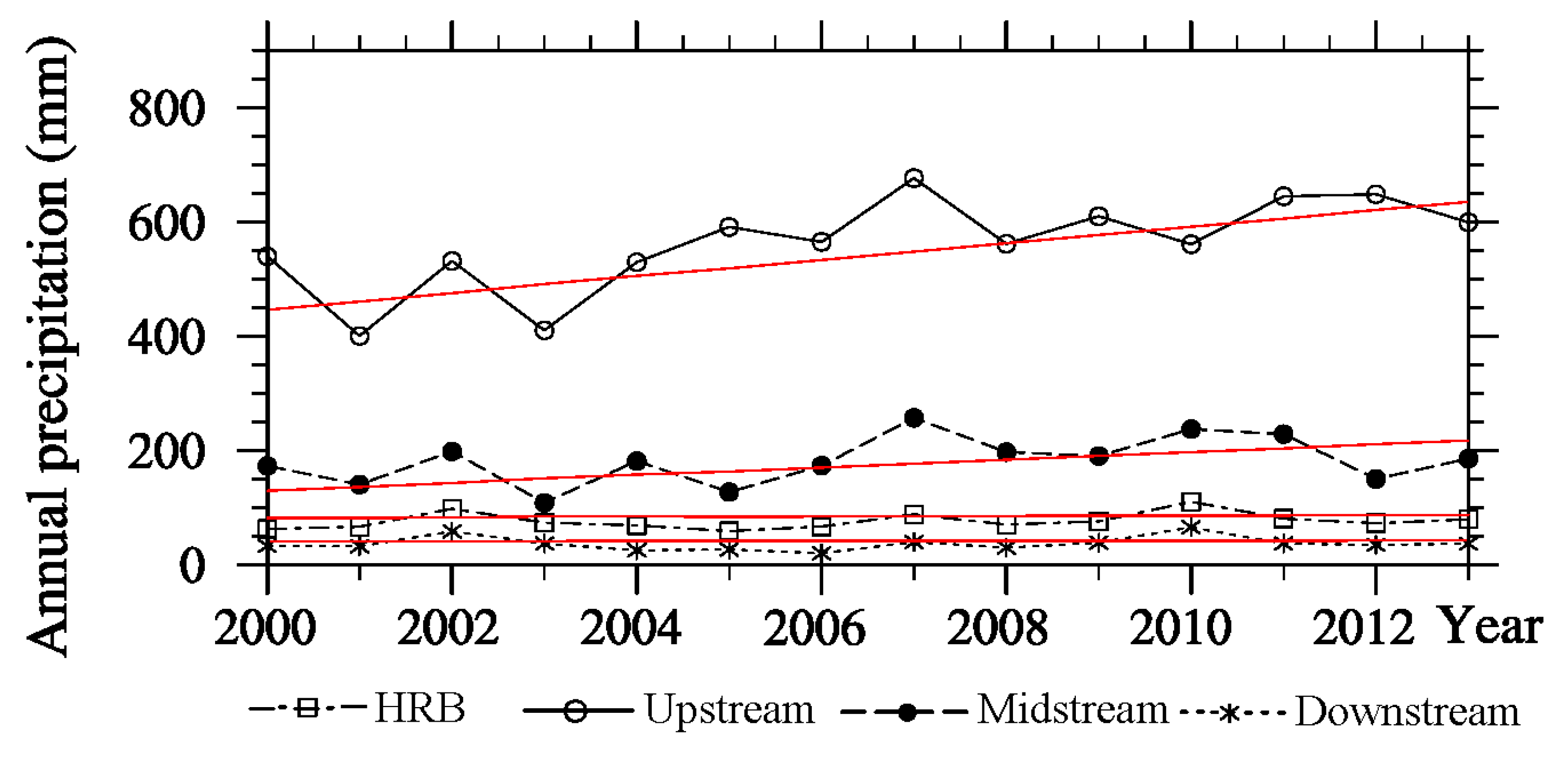
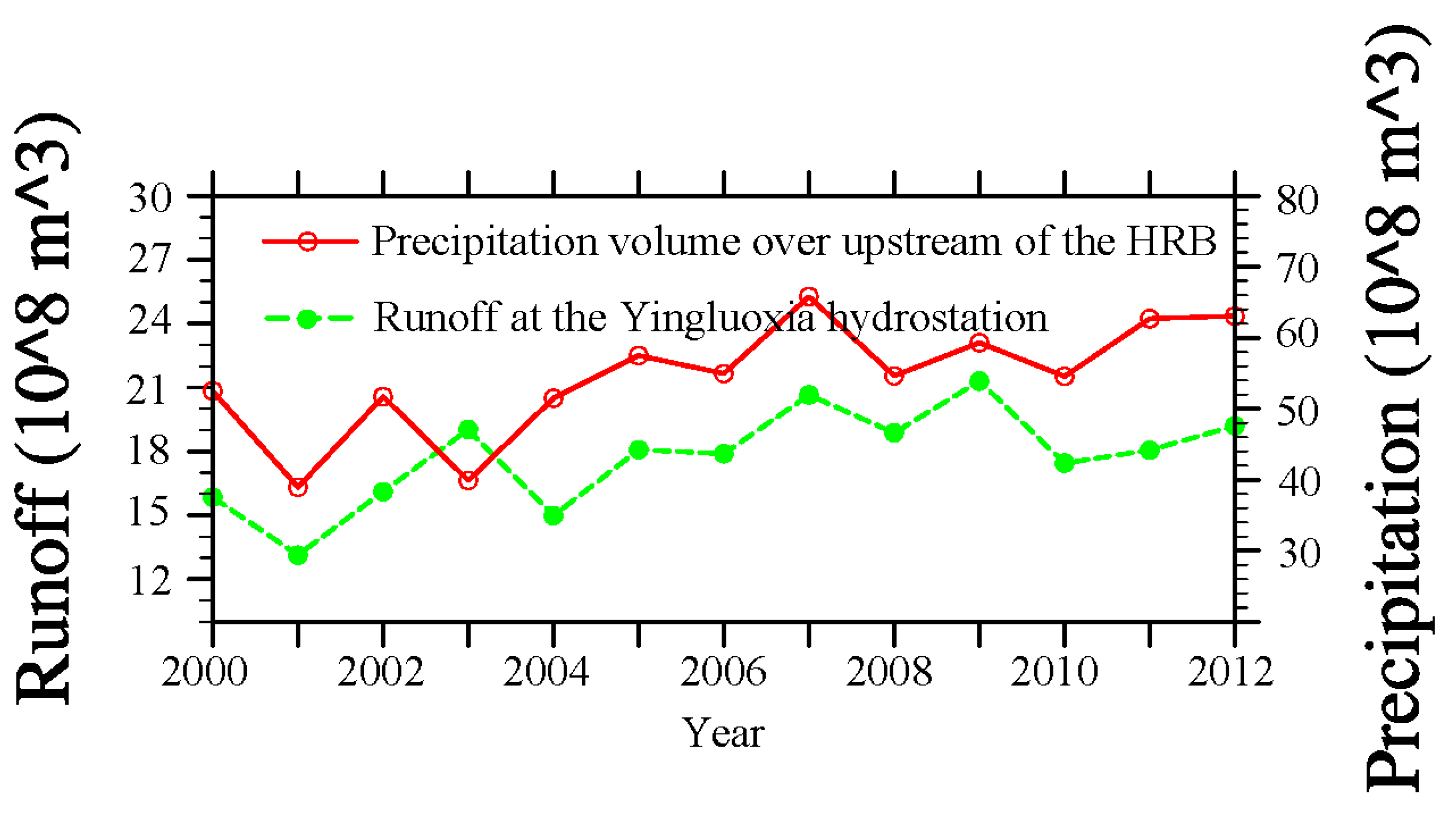
4.3.2. Monthly Precipitation
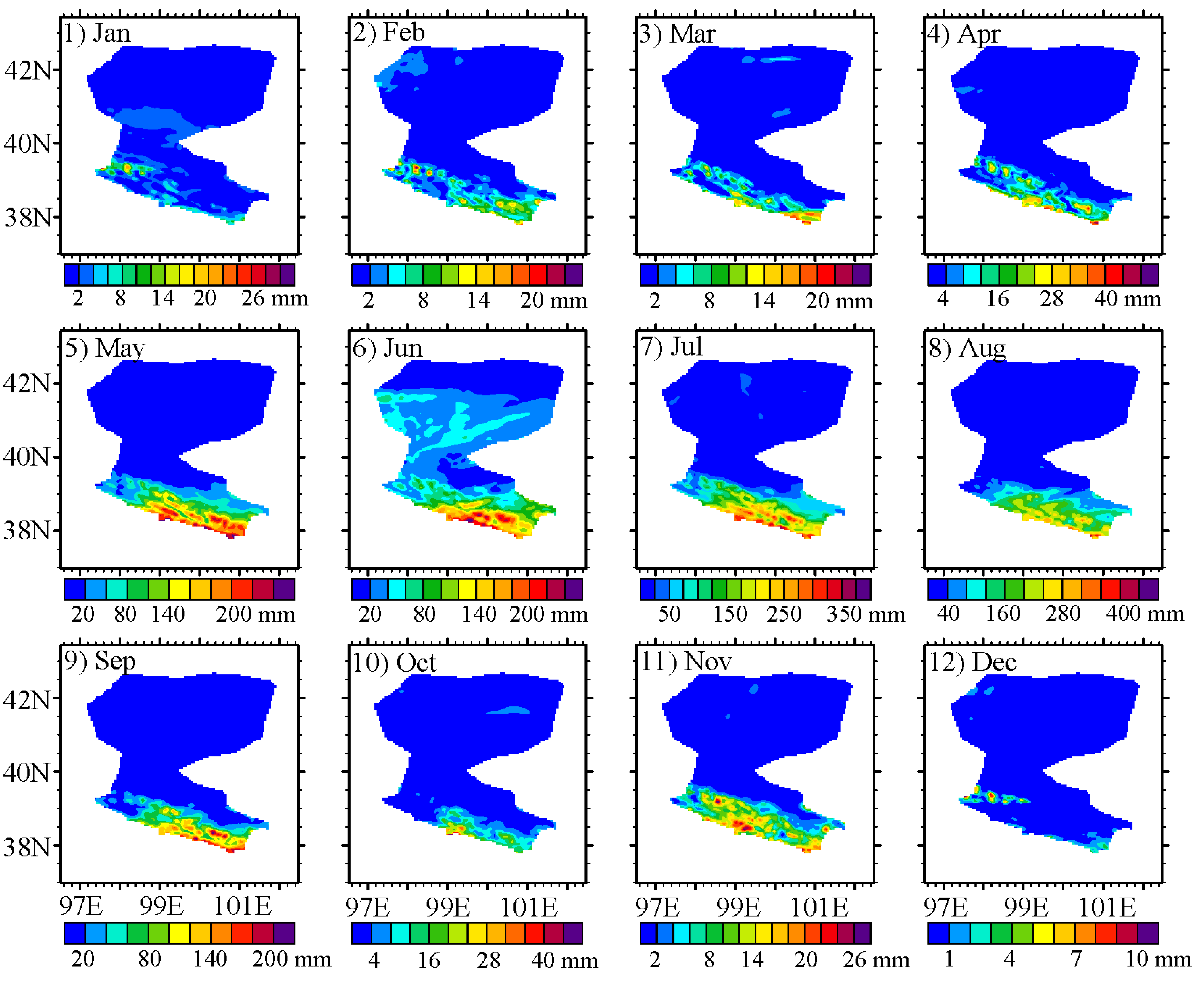

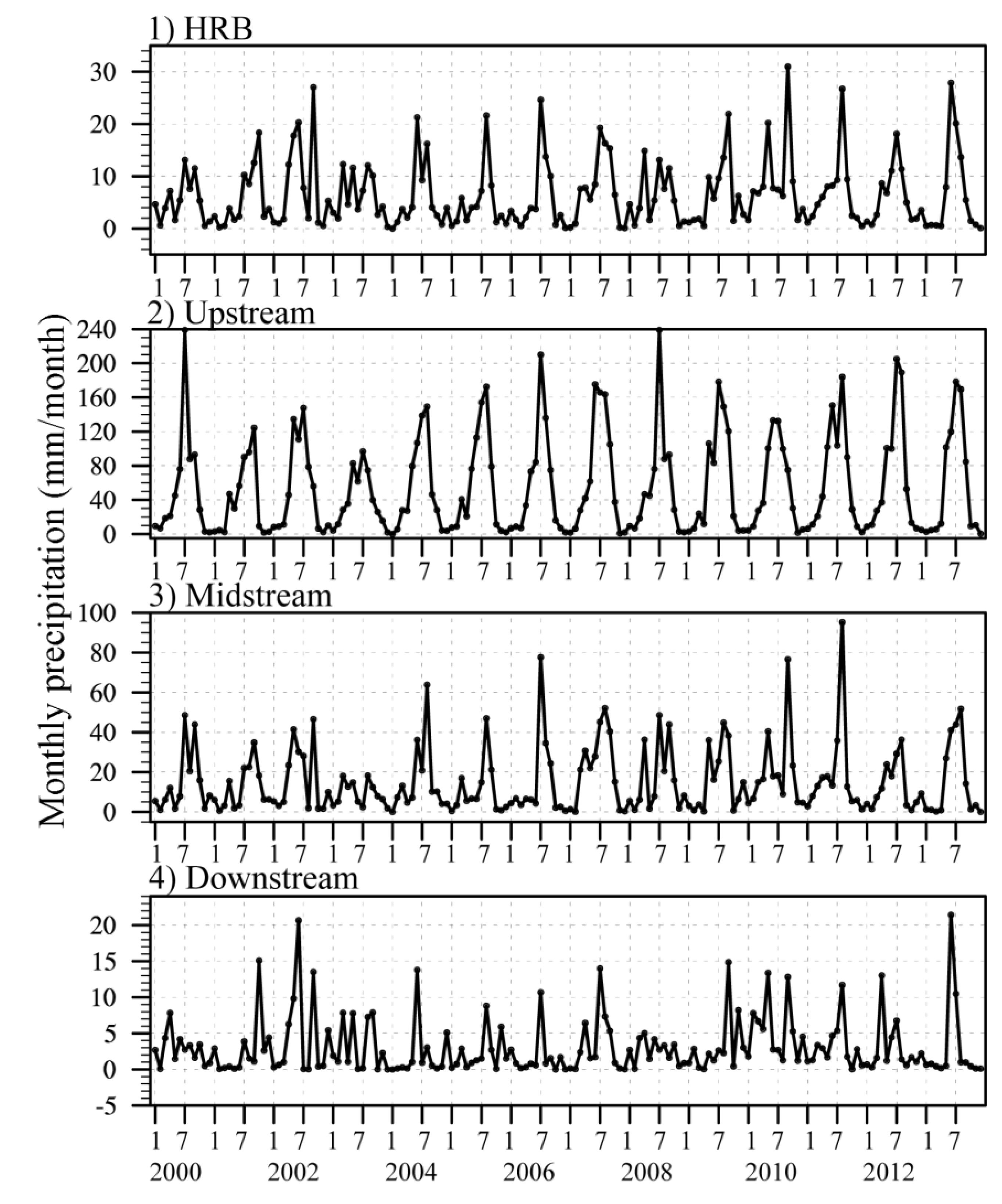
4.3.3. Daily Precipitation
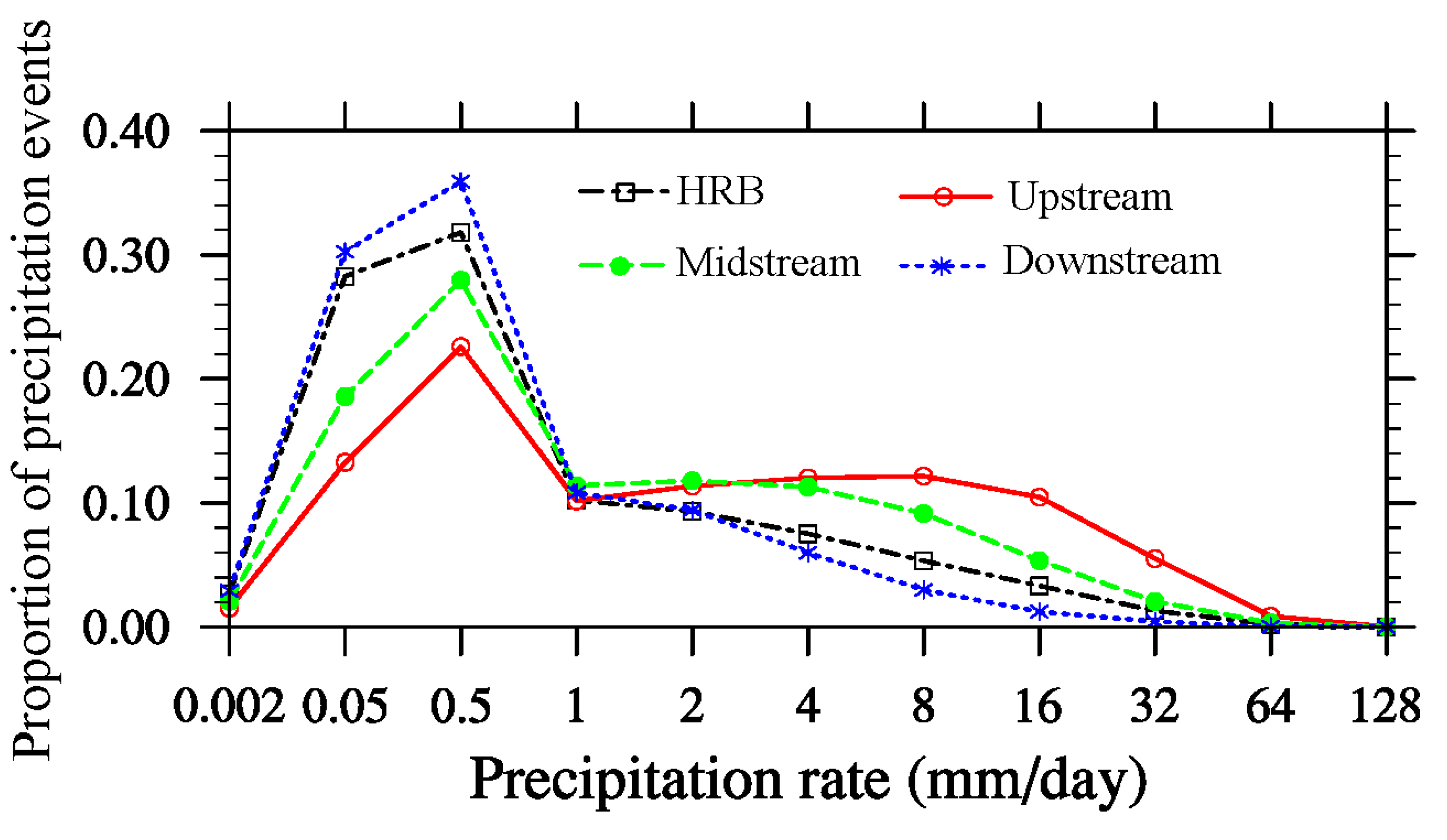
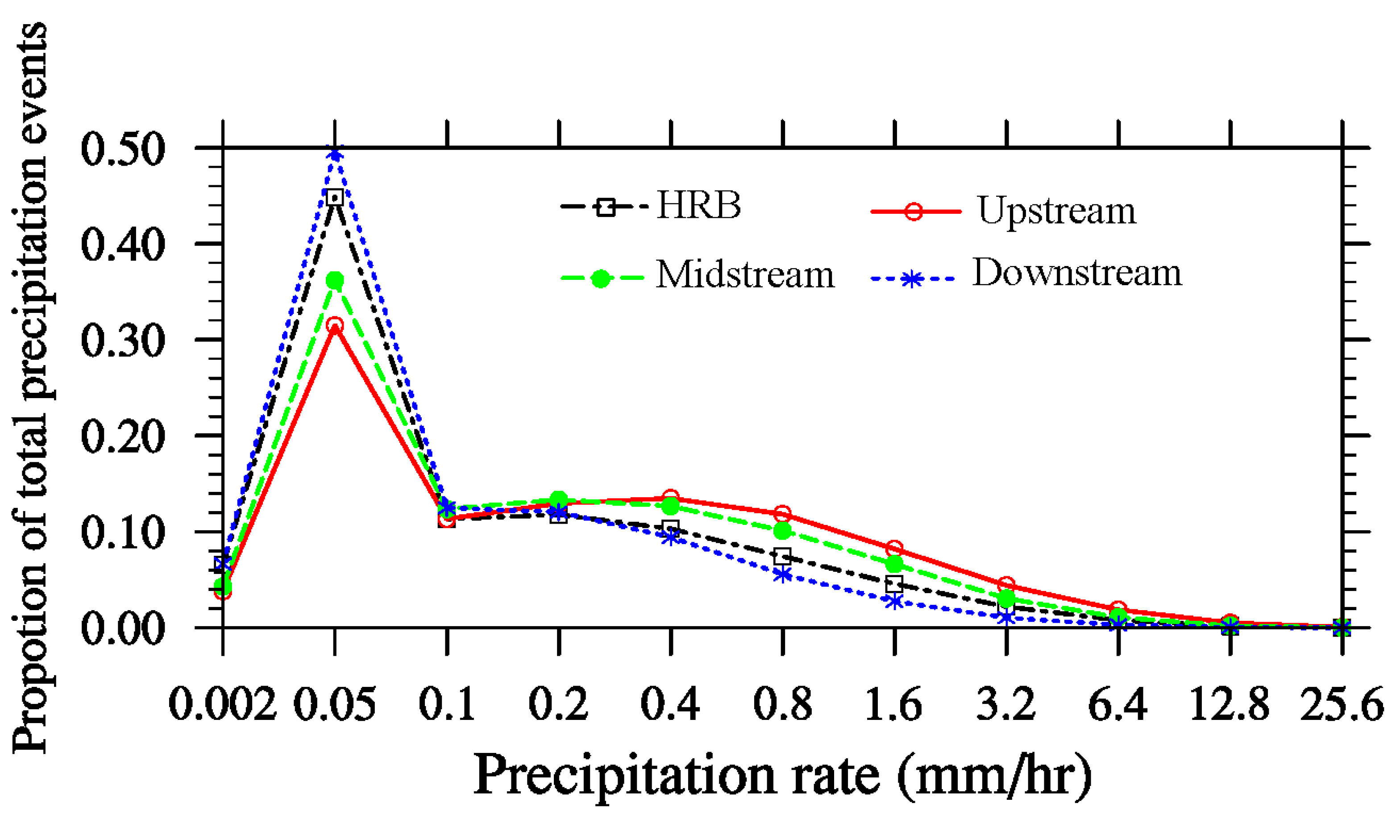
4.3.4. Hourly Precipitation
5. Discussion
5.1. Physical Configuration and Atmospheric-Hydrometeorological Condition over the HRB
5.2. Evaluation for the HRB
6. Conclusions
- Since the year 2000 annual precipitation has gradually increased over the HRB, especially over the upstream and downstream regions;
- Precipitation mostly occurs in summer over the HRB, and is higher in the area influenced by the monsoon, with winter snowfall being distinct at high elevations. Precipitation is higher in the eastern upstream area than in the western upstream area; however, in winter the converse pattern occurs;
- Over the HRB, annual precipitation increases with elevation when elevation is less than 4000 m; the highest precipitation occurs at an altitude of 3500–4000 m. And precipitation on the northern slopes of the Qilian Mountains is higher than on the southern slopes;
- Precipitation over downstream areas is low and unstable
Acknowledgments
Author Contributions
Conflicts of Interest
References
- Chen, L.; Frauenfeld, O.W. A comprehensive evaluation of precipitation simulations over China based on CMIP5 multimodel ensemble projections. J. Geophys. Res. 2014, 119, 5767–5786. [Google Scholar] [CrossRef]
- Liu, Y.B.; Fu, Q.N.; Zhao, X.S.; Dou, C.C. Satellite retrieval of precipitation: An overview. Adv. Earth. Sci. 2011, 26, 1162–1172. [Google Scholar]
- Gottschalck, J.; Meng, J.; Rodell, M.; Houser, P. Analysis of multiple precipitation products and preliminary assessment of their impact on global land data assimilation system land surface states. J. Hydrometeorol. 2005, 6, 573–598. [Google Scholar] [CrossRef]
- Tian, Y.; Peter-Lidard, C.D.; Choudhury, B.J.; Garcia, M. Multitemporal analysis of TRMM-based satellite precipitation products for land data assimilation applications. J. Hydrometeorol. 2007, 8, 1165–1183. [Google Scholar] [CrossRef]
- Sorooshian, S.; AghaKouchak, A.; Arkin, P.; Eylander, J.; Foufoula-Georgiou, E.; Harmon, R.S. Advancing the remote sensing of precipitation. Bull. Amer. Meteor. Soc. 2011, 92, 1271–1272. [Google Scholar] [CrossRef]
- Fekete, B.M.; Vorosmarty, C.J.; Roads, J.O.; Willmott, C.J. Uncertainties in precipitation and their impact on runoff estimates. J. Climate. 2004, 17, 294–304. [Google Scholar] [CrossRef]
- Wilk, J.; Kniveton, D.; Andersson, L.; Layberry, R.; Todd, M.C.; Hughes, D.; Ringrose, S.; Vanderpost, C. Estimating rainfall and water balance over the Okavango River basin for hydrological applications. J. Hydrol. 2006, 331, 18–29. [Google Scholar] [CrossRef]
- Gottardi, F.; Obled, C.; Gailhard, J.; Paquet, E. Statistical reanalysis of precipitation fields based on ground network data and weather patterns: Application over French mountains. J. Hydrol. 2012, 432–433, 154–167. [Google Scholar] [CrossRef]
- McCarthy, J.J.; Canziani, O.F.; Leary, N.A.; Dokken, D.J.; White, K.S. Impacts, Adaptation and Vulnerability, Contribution of Working Group II to the Third Assessment Report of the Intergovernmental Panel on Climate Change; Cambridge University Press: Cambridge, UK, 2001. [Google Scholar]
- Liu, L.; Qian, Y.; Wu, A. Comparison of simulated results of regional climate and GCM in summer over Qinghai-Xizhang Plateau and northwest China. Plateau Meteor. 2000, 19, 313–322. [Google Scholar]
- Liang, X.Z.; Xu, M.; Yuan, X.; Ling, T.; Choi, H.I.; Zhang, F.; Chen, L.; Liu, S.; Su, S.; Qiao, F.; et al. Regional climate-weather research and forecasting model. Bull. Am. Meteor. Soc. 2011, 93, 1363–1387. [Google Scholar] [CrossRef]
- Argüeso, D.; Hidalgo-Muñoz, J.M.; Gámiz-Fortis, S.R.; Esteban-Parra, M.J.; Castro-Díez, Y. High-resolution projections of mean and extreme precipitation over Spain using the WRF model (2070–2099 vs. 1970–1999). J. Geophys. Res. 2012, 117, D12108. [Google Scholar]
- Johnson, G.L.; Hanson, C.L. Topographic and atmospheric influences on precipitation variability over a mountainous watershed. J. Appl. Meteorol. 1995, 34, 68–87. [Google Scholar] [CrossRef]
- Wang, C.; Zhao, C. A study of the spatio-temporal distribution of precipitation in upper researches of Heihe River of China using TRMM data. J. Nat. Resour. 2013, 28, 862–872. [Google Scholar]
- Giorgi, F.; Bates, G.T. The climatological skill of regional model over complex terrain. Mon. Weather Rev. 1989, 117, 2325–2347. [Google Scholar] [CrossRef]
- Dickinson, R.E.; Errico, M.; Giorgi, F.; Bates, G.T. A regional climate model for the western United States. Clim. Change 1989, 15, 383–412. [Google Scholar] [CrossRef]
- Duan, H.X.; Liu, X.W.; Pu, Z.X. Cloud microphysical processes on simulation of precipitation in Qilian Mountains. Trans. Atmos. Sci. 2013, 36, 367–378. [Google Scholar]
- Wang, J.J.; Zhou, B.; Guo, X.R. Numerical study on characteristic of condensational heating rates and their impacts on mesoscale structures of torrential rain simulations. Acta Meteor. Sin. 2005, 63, 405–417. [Google Scholar]
- Lin, W.S.; Li, J.N.; Fan, Q.; Wu, C.S.; Gu, Z.M.; Meng, J.P.; Bueh, C. Numerical simulation of impact of the microphysical parameterization on snowfall over north China. Plateau Meteor. 2007, 26, 107–114. [Google Scholar]
- Xue, G.Y.; Zhang, J.H.; Chen, H.M.; Zhu, X.M. The comparisons of different convective parameterization schemes applying precipitation’s forecast of typhoon landing on Zhejiang and Fujian provinces. Plateau Meteor. 2007, 26, 765–773. [Google Scholar]
- Xu, G.Q.; Liang, X.D.; Yu, H.; Huang, L.P.; Xue, J.S. Precipitation simulation using different cloud-precipitation schemes for a landfall typhoon. Plateau Meteor. 2007, 26, 891–900. [Google Scholar]
- Zhang, D.L. Roles of various diabatic physical processes in mesoscale models. Chin. J. Meteor. Sci. 1998, 22, 548–561. [Google Scholar]
- Liu, W.G.; Liu, Q.J. The numerical simulation of orographic cloud structure and cloud microphysical processes in Qilian Mountains in summer. Part (I): Cloud microphysical scheme and orographic cloud structure. Plateau Meteor. 2007, 26, 1–15. [Google Scholar]
- Liu, W.G.; Liu, Q.J. The numerical simulation of orographic cloud structure and cloud microphysical processes in Qilian Mountains in summer. Part (II): Cloud microphysical processes and orographic influence. Plateau Meteor. 2007, 26, 16–29. [Google Scholar]
- Zhu, Q.L.; Jiang, H.; Wang, K.L.; Luo, X.P. WRF model parameterization of physical processes on Precipitation in the Heihe River Basin simulation influence. Arid Zone Res. 2013, 30, 462–469. [Google Scholar]
- Xiong, Z. Impact of different convective parameterization on simulation of precipitation for the Heihe River Basin. Adv. Earth. Sci. 2014, 29, 590–597. [Google Scholar]
- Ma, S.H.; Zhai, P.M. Effects of initial fields and lateral boundaries on numerical predictions of typhoon track. J. Trop. Meteor. 2004, 20, 737–742. [Google Scholar]
- Li, X.; Li, X.W.; Li, Z.Y.; Ma, M.G.; Wang, J.; Xiao, Q.; Liu, Q.; Che, T.; Chen, E.X.; Yan, G.J.; et al. Watershed allied telemetry experimental research. J. Geophys. Res. 2009, 114. [Google Scholar] [CrossRef]
- Li, X.; Cheng, G.D.; Liu, S.M.; Xiao, Q.; Ma, M.G.; Jin, R.; Che, T.; Liu, Q.H.; Wang, W.Z.; Qi, Y.; et al. Heihe Watershed Allied Telemetry Experimental Research (HiWATER): Scientific objectives and experimental design. Bull. Amer. Meteor. Soc. 2013, 9, 1145–1160. [Google Scholar] [CrossRef]
- Yang, D.; Wang, N.; Ye, B.; Ma, L.J. 2009: Recent advances in precipitation-bias correction and application. Sci. Cold Arid Reg. 2009, 1, 193–198. [Google Scholar]
- Xu, Z.W.; Liu, S.M.; Li, X.; Shi, S.J.; Wang, J.M.; Zhu, Z.L.; Xu, T.R.; Wang, W.Z.; Ma, M.G. Intercomparison of surface energy flux measurement systems used during the HiWATER-MUSOEXE. J. Geophys. Res. 2013, 118, 13140–13157. [Google Scholar] [CrossRef]
- Cheng, G.D.; Li, X.; Zhao, W.Z.; Xu, Z.M.; Feng, Q.; Xiao, S.C.; Xiao, H.L. Integrated study of the water-ecosystem-economy in the Heihe River Basin. Natl. Sci. Rev. 2014, 1, 413–428. [Google Scholar] [CrossRef]
- Cheng, G.D.; Li, X. Integrated research methods in watershed science. Sci. China Earth Sci. 2015, 58, 1159–1168. [Google Scholar] [CrossRef]
- Pan, X.D.; Li, X.; Yang, K.; He, J.; Zhang, Y.L.; Han, X.J. Comparison of downscaled precipitation data over a mountainous watershed: A case study in the Heihe River Basin. J. Hydrometeorol. 2014, 15, 1560–1574. [Google Scholar] [CrossRef]
- He, X.B.; Ye, B.S.; Ding, Y.J. Bias correction for precipitation measurement in Tanggula Moutain Tibetan Plateau. Adv. Water Resour. 2009, 20, 403–408. [Google Scholar]
- Yang, D.Q.; Jiang, T.; Zhang, Y.S.; Kang, E.S. Analysis and correction of errors in precipitation measurement at the head of Urumqi River, Tianshan. J. Glaci. Geocry. 1988, 10, 384–399. [Google Scholar]
- Michalakes, J.; Chen, S.; Dudhia, J.; Hart, L.; Klemp, J.B. Development of a next generation regional weather research and forecast model. In Developments in Teracomputing, Proceedings of the Ninth ECMWF Workshop on the Use of High Performance Computing in Meteorology; World Scientific Publishing: Toh Tuck Link, Singapore, 2001; pp. 269–276. [Google Scholar]
- Michalakes, J.; Dudhia, J.; Gill, D. Design of a next-generation regional weather research and forecast model. In Towards Teracomputing; World Scientific Publishing: Toh Tuck Link, Singapore, 1999; pp. 117–124. [Google Scholar]
- Michalakes, J.; Dudhia, J.; Gill, D. The weather research and forecast model: Software architecture and performance. In Proceedings of the 11th ECMWF Workshop on the Use of High Performance Computing in Meteorology, Reading, UK, 25–29 October 2004.
- Michalakes, J.; Hacker, J.; Loft, R.; McCracken, M.O.; Snavely, A.; Wright, N.J.; Spelce, T.; Gorda, B.; Walkup, R. WRF nature run. J. Phys. Conf. Ser. 2008, 125, 12–22. [Google Scholar] [CrossRef]
- Laprise, R. The Euler equation of motion with hydrostatic pressure as independent coordinate. Mon. Weather Rev. 1992, 120, 197–207. [Google Scholar] [CrossRef]
- Arakawa, A.; Lamb, V.R. Computational design of the basic dynamical processes of the University of California Los Angeles general circulation model. In Methods of Computational Physics; Academic Press: New York, NY, USA, 1977; pp. 173–265. [Google Scholar]
- Pan, X.D.; Li, X.; Ran, Y.H.; Liu, C. Impact of underlying surface information on WRF modeling in Heihe River Basin. Plateau Meteor. 2012, 31, 657–667. [Google Scholar]
- Ran, Y.H.; Li, X.; Lu, L.; Li, Z.Y. Large-scale land cover mapping with the integration of multi-source information based on the Dempster-Shafer theory. Int. J. Geogr. Inf. Sci. 2012, 26, 169–191. [Google Scholar] [CrossRef]
- Shuangguan, W.; Dai, Y.J.; Liu, B.Y.; Ye, A.Z.; Yuan, H. A soil particle-size distribution dataset for regional land and climate modeling in China. Geodema 2012, 171–172, 85–91. [Google Scholar] [CrossRef]
- University Corporation for Atmospheric Research, National Center for Atmospheric Research. 2009. Available online: http://dss.ucar.edu/datasets/ds083.2/ (accessed on 25 March 2015).
- Saha, S.; Moorthi, S.; Pan, H.L.; Wu, X; Wang, J.; Nadiga, S.; Tripp, P.; Kistler, R.; Woollen, J.; Behringer, D.; et al. The NCEP climate forecast system reanalysis. Bull. Amer. Meteor. Soc. 2010, 91. [Google Scholar] [CrossRef]
- Tang, M.C. The distribution of precipitation in mountain Qilian. Acta Geogr. Sin 1985, 40, 323–332. [Google Scholar]
- Zhang, X.C.; Yang, Z.N. The primary analysis of water-balance in Binggou basin of Qilian Mountains. J. Glaci. Geocry. 1991, 13, 35–42. [Google Scholar]
- Ding, Y.J.; Ye, B.S.; Zhou, W.J. Temporal and spatial precipitation distribution in the Heihe catchment, Northwest China, during the past 40a. J. Glaci. Geocry. 1999, 21, 42–48. [Google Scholar]
- Wang, N.L.; He, J.Q.; Jiang, X.; Song, G.J.; Pu, J.C.; Wu, X.B.; Chen, L. Study on the zone of maximum precipitation in the north slopes of the central Qilian Mountains. J. Glaci. Geocry. 2009, 31, 395–403. [Google Scholar]
- Fu, Y.Z.; Cao, L. The area rainfall analysis and climate feature of Heihe River drainage. Gansu Meteor. 2002, 20, 8–10. [Google Scholar]
- Zhang, J.; Li, D.L. Analysis on distribution character of rainfall over Qilian Mountain and Heihe Valley. Plateau Meteor. 2004, 23, 81–88. [Google Scholar]
- Zhang, C.J.; Guo, N. Climatic variation characteristics over Qilian Mountain area during the last 40 years. Meteor. Mon. 2002, 28, 33–40. [Google Scholar]
- Lan, Y.C.; Kang, E.S.; Zhang, J.S.; Hu, X.L. Relationship between ENSO circle and air temperature, precipitation and runoff in the Qilian Mountain region in the past 50 years. Adv. Water Resour. 2002, 13, 141–145. [Google Scholar]
- Cao, L.; Dou, Y.X. The spatial and temporal characteristics and forecasting method of precipitation in Heihe Field. Arid Meteor. 2005, 23, 35–39. [Google Scholar]
- Li, G.C.; Zhang, J.L.; Chen, T.Y. Synoptic analysis of precipitation process in summer of 2006 over Qilian Mountains. Arid Meteor. 2008, 26, 22–28. [Google Scholar]
- Zhang, Q.; Yu, Y.X.; Zhang, J. Characteristics of water cycle in the Qilian Mountains and the oases in Hexi inland river basins. J. Glaci. Geocry. 2008, 30, 907–913. [Google Scholar]
- Yong, B.; Ren, L.L.; Hong, Y.; Wang, J.H.; Gourley, J.J.; Jiang, S.H.; Chen, X.; Wang, W. Hydrologic evaluation of multisatellite precipitation analysis standard precipitation products in basins beyond its inclined latitude band: A case study in Laohahe basin, China. Water Resour. Res. 2010, 46. [Google Scholar] [CrossRef]
- Zhang, J.; Zhao, W.Z. Daily precipitation pattern and its temporal variability in Heihe River Basin. J. Desert Res. 2008, 28, 741–747. [Google Scholar]
© 2015 by the authors; licensee MDPI, Basel, Switzerland. This article is an open access article distributed under the terms and conditions of the Creative Commons Attribution license (http://creativecommons.org/licenses/by/4.0/).
Share and Cite
Pan, X.; Li, X.; Cheng, G.; Li, H.; He, X. Development and Evaluation of a River-Basin-Scale High Spatio-Temporal Precipitation Data Set Using the WRF Model: A Case Study of the Heihe River Basin. Remote Sens. 2015, 7, 9230-9252. https://doi.org/10.3390/rs70709230
Pan X, Li X, Cheng G, Li H, He X. Development and Evaluation of a River-Basin-Scale High Spatio-Temporal Precipitation Data Set Using the WRF Model: A Case Study of the Heihe River Basin. Remote Sensing. 2015; 7(7):9230-9252. https://doi.org/10.3390/rs70709230
Chicago/Turabian StylePan, Xiaoduo, Xin Li, Guodong Cheng, Hongyi Li, and Xiaobo He. 2015. "Development and Evaluation of a River-Basin-Scale High Spatio-Temporal Precipitation Data Set Using the WRF Model: A Case Study of the Heihe River Basin" Remote Sensing 7, no. 7: 9230-9252. https://doi.org/10.3390/rs70709230




